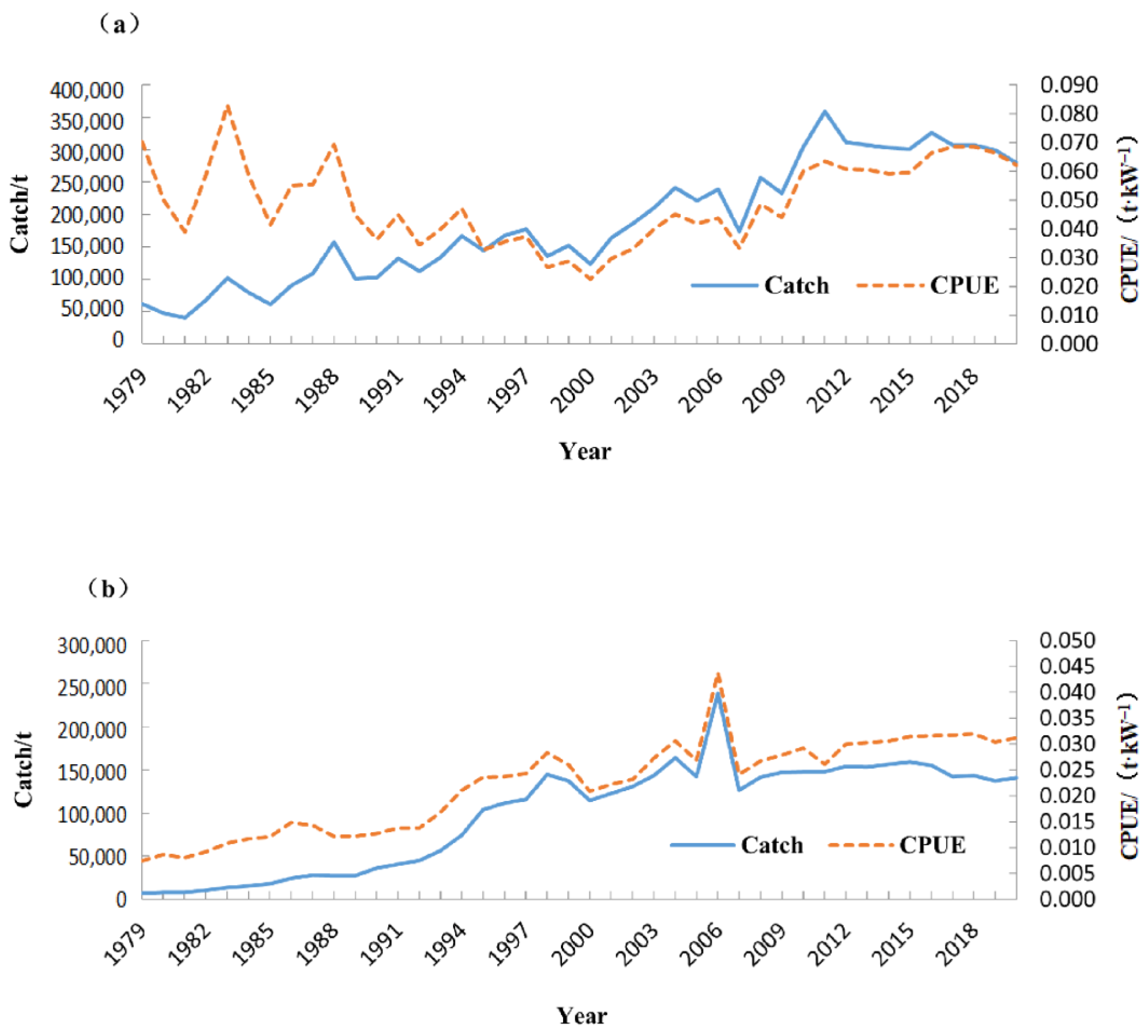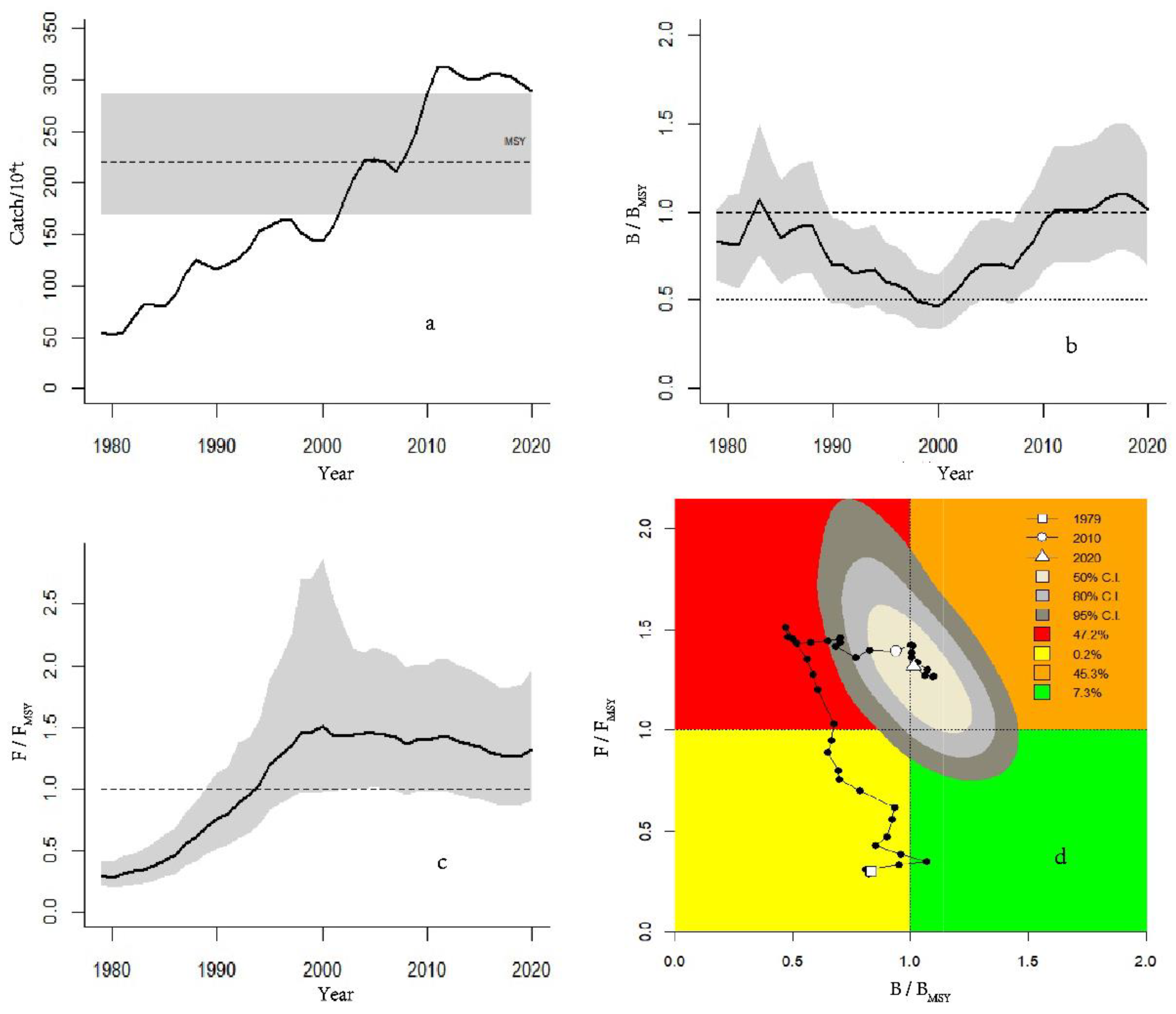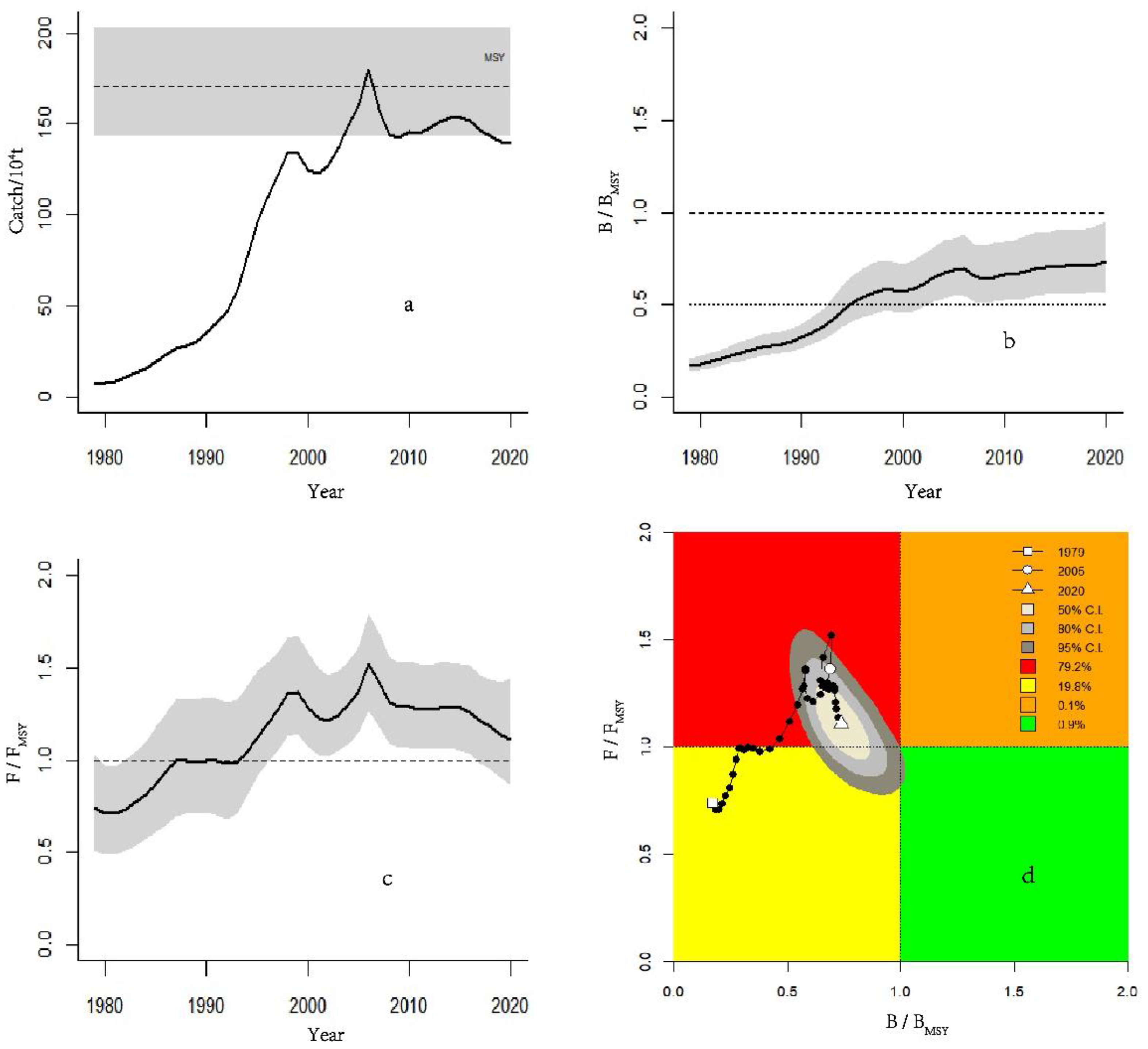Evaluation of Biological Reference Points of Two Important Fishery Resources in the East China Sea
Abstract
1. Introduction
2. Materials and Methods
2.1. Data Source
2.2. Methods
2.3. Data Analysis
3. Results
3.1. Mackerel_ECS
3.2. Conger_ECS
4. Discussion
4.1. Models
4.2. Status of Two Fishery Resources
5. Conclusions
Author Contributions
Funding
Institutional Review Board Statement
Informed Consent Statement
Data Availability Statement
Conflicts of Interest
References
- Liu, Z.; Sun, H.; Yue, D.; Geng, R.; Zhao, L.; Pan, P.; Cao, K. Research on China’s Maintance Policy for Marie Capture Fishery Resources in the New Era. J. Agric. Sci. Technol. 2018, 20, 1–8. [Google Scholar]
- Lu, Z.; Cui, L.; Pauly, D. Assessments of 16 Exploited Fish Stocks in Chinese Waters Using the CMSY and BSM Methods. Front. Mar. Sci. 2020, 7, 483993. [Google Scholar]
- Han, Y.; Rita, C.; Li, Y.R.; Ma, Z.J.; Wang, Y.N. Management of marine fishery share in the United States—And its enlightenment to China’s marine fishery management. World Agric. 2017, 3, 78–84. [Google Scholar]
- Zhang, K.; Liao, B.C.; Xu, Y.W.; Zhang, J.; Sun, M.; Qiu, Y.; Chen, Z. Assessment for allowable catch of fishery resources in the South China Sea based on statistical data. Haiyang Xuebao 2017, 39, 25–33. [Google Scholar]
- Zhao, L.H. Research on the Implementation of Fishing Quota System in China’s Marine Fisheries. Ph.D. Thesis, Shanghai Ocean University, Shanghai, China, 27 May 2020. [Google Scholar]
- Liu, Z.; Yuan, X.; Yang, L.; Yan, L.; Cheng, J. Stock assessment and management strategies for small yellow croaker in the East China Sea based on data-limited assessment models. J. Fish. Sci. China 2019, 26, 621–635. [Google Scholar]
- Zhan, B.Y. Fishery Stock Assessment; China Agricultural Press: Beijing, China, 1995. [Google Scholar]
- Haddon, M. Modeling and Quantitative Methods in Fisheries, 2nd ed.; Chapman & Hall/CRC Press: New York, NY, USA; London, UK, 2011; pp. 285–333. [Google Scholar]
- Ji, Y.; Liu, Q.; Liao, B.; Zhang, Q.; Han, Y.N. Estimating biological reference points for Largehead hairtail (Trichiurus lepturus) fishery in the Yellow Sea and Bohai Sea. Acta Oceanol. Sin. 2019, 38, 20–26. [Google Scholar] [CrossRef]
- Froese, R.; Demirel, N.; Coro, G.; Kleisner, K.M.; Winker, H. Estimating fisheries reference points from catch and resilience. Fish Fish. 2017, 18, 506–526. [Google Scholar] [CrossRef]
- Chen, W.Z.; Li, C.S.; Yu, L.F. Estimation of the maximum sustainable yield for chub mackerel and round scad in the East China Sea by the surplus production models fitting expert system. J. Fish. China 1997, 4, 404–408. [Google Scholar]
- Yan, L.P.; Li, J.S.; Ling, J.Z.; Ye, S.Z.; Zhang, H.L. Assessment on the biomass of Scomber japonicus resources in the western East China Sea by length-structure VPA. Prog. Fish. Sci. 2010, 31, 16–22. [Google Scholar]
- Li, G.; Zheng, X.Q.; Zhu, G.P.; Chen, X.J. Establishment of surplus production model for chub mackerel (Scomber japonicus) in the East China Sea and Yellow Sea based on the sea surface temperature. J. Shanghai Ocean. Univ. 2011, 20, 108–113. [Google Scholar]
- Ling, J.Z.; Li, S.F.; Yan, L.P. Analysis on the utilization of main fishery resources in the East China Sea. Mar. Fish. 2006, 2, 111–116. [Google Scholar]
- Zhou, Y.D.; Xu, H.X. Biomass Estimates of Muraenesox cinereus are Calculated by LCA in the East China Sea. J. Zhejiang Ocean. Univ. (Nat. Sci.) 2007, 4, 399–403. [Google Scholar]
- Bureau of Fisheries of the Ministry of Agriculture of the People’s Republic of China. China Fishery Statistical Yearbook; China Agriculture Press: Beijing, China, 1979–2021. [Google Scholar]
- Zhang, Q.Q.; Liu, Q. Assessing biological reference points for three important fishery resources in coastal water of China. Period. Ocean. Univ. China 2021, 51, 123–134. [Google Scholar]
- Steven Martell and Rainer Froese. A simple method for estimating MSY from catch and resilience. Fish Fish. 2013, 14, 504–514. [Google Scholar] [CrossRef]
- Froese, R.; Pauly, D. (Eds.) FishBase. World Wide Web Electronic Publication. Version (02/2022). Available online: www.fishbase.org (accessed on 31 December 2022).
- Froese, R.; Demirel, N.; Coro, G.; Winker, H. A Simple User Guide for CMSY+ and BSM (CMSY_2019_9f. R); Oceanrep: Kiel, Germany, 2019; pp. 1–16. [Google Scholar]
- Guan, W.J.; Tian, S.Q.; Zhu, J.F.; Chen, X.J. A review of fisheries stock assessment models. J. Fish. Sci. China 2013, 20, 1112–1120. [Google Scholar] [CrossRef]
- Zhang, S.; Wang, Y.; Wang, Y.; Liang, C.; Xian, W. Assessment of 11 Exploited Fish and Invertebrate Populations in the Japan Sea Using the CMSY and BSM Methods. Front. Mar. Sci. 2020, 7, 525363. [Google Scholar] [CrossRef]
- Rosenberg, A.A.; Fogarty, M.J.; Cooper, A.B.; Dickey-Collas, M.; Fulton, E.A.; Gutiérrez, N.L.; Hyde, K.J.; Kleisner, K.M.; Kristiansen, T.; Longo, C.; et al. Developing new approaches to global stock status assessment and fishery production potential of the seas. FAO Fish. Aquac. Circ. 2014, 1086, 1–190. [Google Scholar]
- Nisar, U.; Ali, R.; Mu, Y.; Sun, Y. Assessing Five Major Exploited Tuna Species in India (Eastern and Western Indian Ocean) Using the Monte Carlo Method (CMSY) and the Bayesian Schaefer Model (BSM). Sustainability 2021, 13, 8868. [Google Scholar] [CrossRef]
- Geng, P. A Study of Inter-Annual Changes in Growth, Mortality and Exploitation Rate of Representative Fish Stocks in Beibu Gulf. Ph.D. Thesis, Shanghai Ocean University, Shanghai, China, May 2019. [Google Scholar]
- Zeng, L.; Li, X.S.; Zhao, X.Y.; Li, F.; Jin, X.S. Fecundity and its variations of anchovy Engraulis japonicus in the central and southern Yellow Sea. J. Fish. Sci. China 2005, 12, 569–574. [Google Scholar]
- Zhang, K.; Zhang, J.; Xu, Y.; Sun, M.; Chen, Z.; Yuan, M. Application of a catch-based method for stock assessment of three important fisheries in the East China Sea. Acta Oceanol. Sin. 2018, 37, 102–109. [Google Scholar] [CrossRef]
- Li, Y.K.; Fang, X.N.; Yu, W.; Li, Y. Spatio-temporal distribution of chub mackerel Scomber japonicus in the East China Sea during 2005–2016 and its relationship with sea surface temperature. J. Shanghai Ocean. Univ. 2022, 31, 710–720. [Google Scholar]
- Wu, S.N.; Chen, X.J. Review on Stock Assessment and Management of Chub Mackerel (Scomber japonicus). Trans. Oceanol. Limnol. 2020, 1, 161–168. [Google Scholar]
- Li, Y.S.; Bai, S.L.; Pan, L.Z.; Guan, W.J.; Jiao, J.P. An Individual Model Based Simulation Study on Impact of Water Temperature Fluctuation on Recruitment of Chub mackerel (Scomber japonicus) in the East China Sea. Trans. Oceanol. Limnol. 2018, 6, 118–124. [Google Scholar]
- Zhou, H.L.; Yan, L.P.; Zhang, H.; Li, J.S. Age and growth characteristics of chub mackerel (Scomber japonicus) reproductive stock in the central East China Sea. J. Fish. Sci. China 2022, 29, 608–617. [Google Scholar]
- Guan, W.J.; Ma, X.L. Assessment of the status of Scomber japonicus resources in the East China Sea and Yellow Sea using a Bayesian biomass dynamic model. J. Shanghai Ocean. Univ. 2022, 31, 749–760. [Google Scholar]
- Li, Y.S.; Xing, Y.N.; Pan, L.Z.; Zhang, Y.; Yu, W. Research progress on life history and model application of chub mackerel Scomber japonicus: A review. J. Dalian Ocean. Univ. 2021, 36, 694–705. [Google Scholar]
- Zhou, H.L.; Li, J.S.; Yan, L.P. Research progress on biological characteristics of reproductive stocks and population ecology of Scomber japonicus. Mar. Fish. 2021, 43, 751–760. [Google Scholar]
- Zhang, Y.Z.; Zhu, W.B.; Li, P.F. Seasonal and Growth Variation of Feeding Habit of Conger Eel (Muraenesox cinereus) in East China Sea. J. Zhejiang Ocean. Univ. (Nat. Sci.) 2010, 29, 237–245. [Google Scholar]
- Li, Q.; Zhang, C.; Ye, Z.J.; Tian, Y.J.; Liu, Y.; Li, J.C. A comparative study on growth and mortality of Muraenesox cinereus and M. bagio in East China Sea and Yellow Sea. Period. Ocean. Univ. China 2019, 49 (Suppl. II), 46–52. [Google Scholar]
- Mo, Q.L.; Hu, S.S.; Xie, J.J.; Luo, J.H.; Feng, B. Stock assessment of Muraenesox cinereus in the northern South China Sea. Fish. Inf. Strategy 2022, 37, 27–33. [Google Scholar]
- Sun, M.; Li, Y.; Chen, Y. Unveiling unselective fishing in China: A nationwide meta-analysis of multispecies fisheries. Fish Fish. 2022, 24, 142–158. [Google Scholar] [CrossRef]




| Resilience | Prior r-Range |
|---|---|
| High | 0.6–1.5 |
| Medium | 0.2–0.8 |
| Low | 0.05–0.5 |
| Very low | 0.015–0.1 |
| Depletion Status of the Stock | B/k |
|---|---|
| Very strong depletion | 0.01–0.2 |
| Strong depletion | 0.01–0.4 |
| Medium depletion | 0.2–0.6 |
| Low depletion | 0.4–0.8 |
| Nearly unexploited | 0.75–1.0 |
| Methods | Input Values | Mackerel_ECS | Conger_ECS |
|---|---|---|---|
| CMSY and BSM | r/a−1 | 0.2~0.8 | 0.2~0.8 |
| Initial B/k | 0.01~0.4 | 0.01~0.4 | |
| Intermediate B/k | 0.2~0.6 (2010) | 0.2~0.6 (2005) | |
| Final B/k | 0.2~0.6 | 0.2~0.6 |
| Fisheries | Methods | r (1/Year) | k/103t | MSY/103t | F/FMSY | B/BMSY |
|---|---|---|---|---|---|---|
| Mackerel_ECS | CMSY | 0.499 (0.293~0.850) | 2020 (1330~3050) | 240 (200~310) | 1.800 (1.015~2.708) | 0.617 (0.410~1.095) |
| BSM | 0.286 (0.183~0.446) | 3080 (2030~4660) | 220 (170~290) | 1.320 (0.912~1.97) | 1.010 (0.698~1.330) | |
| Conger_ECS | CMSY | 0.524 (0.329~0.835) | 1090 (740~1610) | 140 (120~170) | 1.289 (0.842~2.34) | 0.765 (0.422~1.173) |
| BSM | 0.376 (0.270~0.523) | 1810 (1310~2510) | 170 (140~200) | 1.110 (0.863~1.440) | 0.736 (0.567~0.950) |
Disclaimer/Publisher’s Note: The statements, opinions and data contained in all publications are solely those of the individual author(s) and contributor(s) and not of MDPI and/or the editor(s). MDPI and/or the editor(s) disclaim responsibility for any injury to people or property resulting from any ideas, methods, instructions or products referred to in the content. |
© 2023 by the authors. Licensee MDPI, Basel, Switzerland. This article is an open access article distributed under the terms and conditions of the Creative Commons Attribution (CC BY) license (https://creativecommons.org/licenses/by/4.0/).
Share and Cite
Yin, F.; Liu, Q.; Chen, X. Evaluation of Biological Reference Points of Two Important Fishery Resources in the East China Sea. J. Mar. Sci. Eng. 2023, 11, 121. https://doi.org/10.3390/jmse11010121
Yin F, Liu Q, Chen X. Evaluation of Biological Reference Points of Two Important Fishery Resources in the East China Sea. Journal of Marine Science and Engineering. 2023; 11(1):121. https://doi.org/10.3390/jmse11010121
Chicago/Turabian StyleYin, Fuzheng, Qun Liu, and Xu Chen. 2023. "Evaluation of Biological Reference Points of Two Important Fishery Resources in the East China Sea" Journal of Marine Science and Engineering 11, no. 1: 121. https://doi.org/10.3390/jmse11010121
APA StyleYin, F., Liu, Q., & Chen, X. (2023). Evaluation of Biological Reference Points of Two Important Fishery Resources in the East China Sea. Journal of Marine Science and Engineering, 11(1), 121. https://doi.org/10.3390/jmse11010121





